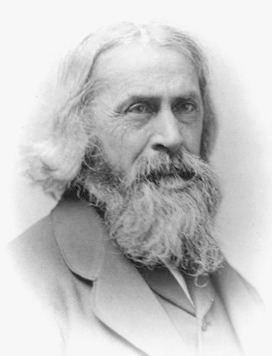
Charles Sanders Peirce was an American scientist, mathematician, logician, and philosopher who is sometimes known as "the father of pragmatism". According to philosopher Paul Weiss, Peirce was "the most original and versatile of America's philosophers and America's greatest logician". Bertrand Russell wrote "he was one of the most original minds of the later nineteenth century and certainly the greatest American thinker ever".

A logic gate is a device that performs a Boolean function, a logical operation performed on one or more binary inputs that produces a single binary output. Depending on the context, the term may refer to an ideal logic gate, one that has, for instance, zero rise time and unlimited fan-out, or it may refer to a non-ideal physical device.
Classical logic or Frege–Russell logic is the intensively studied and most widely used class of deductive logic. Classical logic has had much influence on analytic philosophy.

William Stanley Jevons was an English economist and logician.

John Venn, FRS, FSA was an English mathematician, logician and philosopher noted for introducing Venn diagrams, which are used in logic, set theory, probability, statistics, and computer science. In 1866, Venn published The Logic of Chance, a groundbreaking book which espoused the frequency theory of probability, arguing that probability should be determined by how often something is forecast to occur as opposed to "educated" assumptions. Venn then further developed George Boole's theories in the 1881 work Symbolic Logic, where he highlighted what would become known as Venn diagrams.

"Pragmaticism" is a term used by Charles Sanders Peirce for his pragmatic philosophy starting in 1905, in order to distance himself and it from pragmatism, the original name, which had been used in a manner he did not approve of in the "literary journals". Peirce in 1905 announced his coinage "pragmaticism", saying that it was "ugly enough to be safe from kidnappers". Today, outside of philosophy, "pragmatism" is often taken to refer to a compromise of aims or principles, even a ruthless search for mercenary advantage. Peirce gave other or more specific reasons for the distinction in a surviving draft letter that year and in later writings. Peirce's pragmatism, that is, pragmaticism, differed in Peirce's view from other pragmatisms by its commitments to the spirit of strict logic, the immutability of truth, the reality of infinity, and the difference between (1) actively willing to control thought, to doubt, to weigh reasons, and (2) willing not to exert the will, willing to believe. In his view his pragmatism is, strictly speaking, not itself a whole philosophy, but instead a general method for the clarification of ideas. He first publicly formulated his pragmatism as an aspect of scientific logic along with principles of statistics and modes of inference in his "Illustrations of the Logic of Science" series of articles in 1877-8.

Benjamin Peirce was an American mathematician who taught at Harvard University for approximately 50 years. He made contributions to celestial mechanics, statistics, number theory, algebra, and the philosophy of mathematics.
In semiotics, a sign is anything that communicates a meaning that is not the sign itself to the interpreter of the sign. The meaning can be intentional, as when a word is uttered with a specific meaning, or unintentional, as when a symptom is taken as a sign of a particular medical condition. Signs can communicate through any of the senses, visual, auditory, tactile, olfactory, or taste.
In logic, anti-psychologism is a theory about the nature of logical truth, that it does not depend upon the contents of human ideas but exists independent of human ideas.

An existential graph is a type of diagrammatic or visual notation for logical expressions, created by Charles Sanders Peirce, who wrote on graphical logic as early as 1882, and continued to develop the method until his death in 1914. They include both a separate graphical notation for logical statements and a logical calculus, a formal system of rules of inference that can be used to derive theorems.

The history of computer science began long before the modern discipline of computer science, usually appearing in forms like mathematics or physics. Developments in previous centuries alluded to the discipline that we now know as computer science. This progression, from mechanical inventions and mathematical theories towards modern computer concepts and machines, led to the development of a major academic field, massive technological advancement across the Western world, and the basis of a massive worldwide trade and culture.

Allan Marquand was an art historian at Princeton University and a curator of the Princeton University Art Museum. Marquand is notable as one of the foremost art historians and critics of his time, and helped to popularize and establish the field in elite college campuses. Along with his contemporary, Harvard's Charles Eliot Norton, Marquand was the first academic to bring the serious, academic study of art history into American collegiate curricula.

Benjamin Ives Gilman (1852–1933) was notable as the Secretary of the Boston Museum of Fine Arts from 1893 to 1925. Beginning with the museum as a curator and librarian, he held a variety of positions during this time. As Secretary, he focused on communications and advising the Director and Board on enhancing the museum experience for visitors. He encouraged the display of original art and introduced the practice of having docents aid visitors in their engagement with art.

This Charles Sanders Peirce bibliography consolidates numerous references to the writings of Charles Sanders Peirce, including letters, manuscripts, publications, and Nachlass. For an extensive chronological list of Peirce's works, see the Chronologische Übersicht on the Schriften (Writings) page for Charles Sanders Peirce.

Arthur Walter Burks was an American mathematician who worked in the 1940s as a senior engineer on the project that contributed to the design of the ENIAC, the first general-purpose electronic digital computer. Decades later, Burks and his wife Alice Burks outlined their case for the subject matter of the ENIAC having been derived from John Vincent Atanasoff. Burks was also for several decades a faculty member at the University of Michigan in Ann Arbor.

Christine Ladd-Franklin was an American psychologist, logician, and mathematician.

Charles Sanders Peirce began writing on semiotics, which he also called semeiotics, meaning the philosophical study of signs, in the 1860s, around the time that he devised his system of three categories. During the 20th century, the term "semiotics" was adopted to cover all tendencies of sign researches, including Ferdinand de Saussure's semiology, which began in linguistics as a completely separate tradition.

On May 14, 1867, the 27–year-old Charles Sanders Peirce, who eventually founded pragmatism, presented a paper entitled "On a New List of Categories" to the American Academy of Arts and Sciences. Among other things, this paper outlined a theory of predication involving three universal categories that Peirce continued to apply in philosophy and elsewhere for the rest of his life. The categories demonstrate and concentrate the pattern seen in "How to Make Our Ideas Clear", and other three-way distinctions in Peirce's work.

The philosopher Charles Sanders Peirce (1839–1914) did considerable work over a period of years on the classification of sciences. His classifications are of interest both as a map for navigating his philosophy and as an accomplished polymath's survey of research in his time. Peirce himself was well grounded and produced work in many research fields, including logic, mathematics, statistics, philosophy, spectroscopy, gravimetry, geodesy, chemistry, and experimental psychology.










